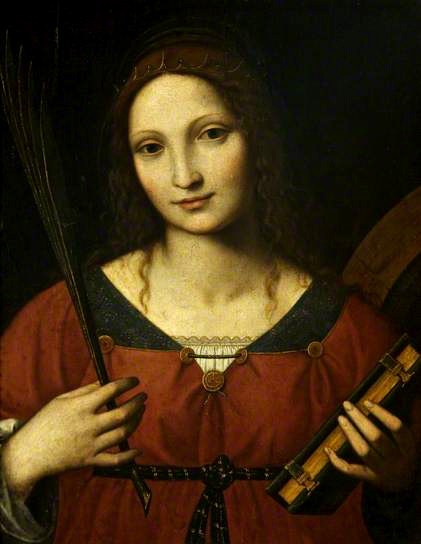In one of those ironies of God’s history – choosing what seems weak to confound the apparently strong – the patron saint of philosophers is a teenage virgin martyr from the fourth century. Catherine of Alexandria (+305) dedicated herself to study ‘from a young age’, as her disputed biography (written centuries after her death) relates. In a contest arranged by the emperor Maxentius, young Catherine bested the best pagan philosophers of her time. When Maxentius perceived she could not be beaten by logic and argument, he attempted to win her over in his own clumsy way by the art, if you will, of love, with an impromptu proposal of marriage, which Catherine of course refused, being already wedded to Christ, besides her awareness of the futility, incompatibility and ineluctable unhappiness of such a union. In his anger – hell hath no fury like an emperor scorned – Maxentius had her tied to a torture wheel to ‘break’ her, but the wheel broke instead (hence, the mediaeval ‘Catherine Wheel’). In the end, Catherine was summarily beheaded.
While in prison awaiting death, she was fed miraculously by a dove, and her wounds tended by angels – for she had been cruelly scourged – the pure goodness of the saint converted hundreds to the Faith, including the emperor’s own wife. After death, her body was transported to Mount Catherine, in Egypt, next to Mount Sinai, where her reputedly incorrupt body still resides in the famous monastery named after her, which has stood since its foundation in the mid-sixth century. It is in the hands of the ‘Orthodox’ – but Catherine is likely one mighty spiritual force in the ecumenical movement.
Some revisionists claim that Catherine’s story is actually an inversion of the later death of the pagan philosopher-mathematician Hypatia (+415), who was lynched by a mob comprised of Christian ‘lectors’ – apparently for political reasons. Hypatia’s ‘martyrdom’ is one of those anti-Catholic tropes, hyperbolically exaggerated from its origins in a complex history, along with Galileo, the Inquisition, the Crusades, and so on.
But Catherine’s historical veracity is attested by the consistent devotion of the faithful, who have always been attached to her intercession as one of the most popular of early saints. It was Saint Catherine who appeared to Joan of Arc, prompting her on her own military mission in freeing France from English domination in the 15th century.
Perhaps in response to such sensus fidelium, Catherine’s feast, removed in the sometimes too-hasty revisions after Vatican II, was put back into the universal calendar in 2002 on this day, November 25th, under Saint John Paul II, no mean philosopher himself. She is also the patron saint of unmarried women and students.
Besides her philosophical acumen, Catherine’s name means ‘purified’ and ‘cleansed’, a fitting thought in today’s all-too impure world, mired in deviance of various forms, and getting more degraded. As the Catechism declares, there is a deep connection between “charity; chastity or sexual rectitude; love of truth and orthodoxy of faith“, or, as it may be put “between purity of heart, of body and of faith” (cf., #2518).
This is a large part of the reason why the modern world cannot see truths which seem so obvious and clear. Pope John Paul in Evangelium Vitae taught that one of the primary causes of the current abortion holocaust is the ‘trivialization of sexuality’. Saint Thomas rightly claimed – and evidence is not wanting – that nothing so blinds the mind and distorts the reason as lust, and his own angelic chastity, which he maintained from his youth, was a large part of the reason he could see the truth so clearly. Alas, the world – and even many members of the Church on earth – immersed in a blizzard of lustful lies, are now learning this the long, long way around.
Pray to Saint Catherine, that we all may be given pure hearts, as well as eyes to see, and ears to hear.











